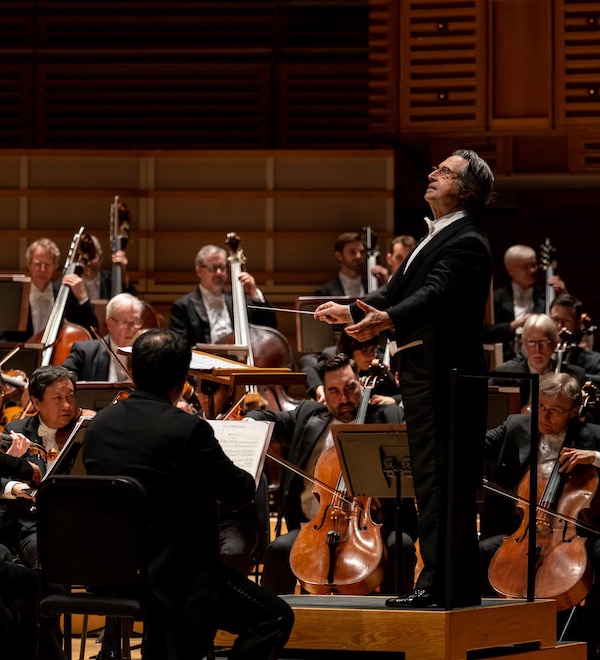Muti, Chicago Symphony bring fire and precision to Arsht Center

For sheer ensemble precision and glowing corporate sonority, the Chicago Symphony Orchestra may be in a class of its own among North American symphonic organizations. Last season music director Riccardo Muti and the Chicagoans gave a sensational concert at the Arsht Center. On Tuesday night they returned to the Knight Concert Hall stage in a program that mixed familiar works by Wagner and Dvořák with a revival of a major score by Paul Hindemith.
Firing on all cylinders, Muti and his well-drilled players did not disappoint. The first tremolo chord of Wagner’s Overture to The Flying Dutchman immediately displayed the unique Chicago string sound, both gleaming and brilliant. Rock- solid horns intoned the doomed captain’s theme and the winds’ collective tonal glow brought an almost vocal fluidity to the melody from Senta’s ballad. The music of the tempestuous sea really stormed with David Herbert’s powerful timpani. Soaring strings and Sarah Bullen’s harp encompassed the lyrical contrast of the final apotheosis.
Hindemith’s symphony Mathis der Maler was once a staple of the symphonic repertoire. In recent decades, however, it has fallen off the radar—as have most of the composer’s works—so Muti’s advocacy for this nearly thirty-minute opus was doubly welcome.
Based on thematic material for his opera about the life of the painter Mathias Grünewald, the symphony (premiered in 1934 by Wilhelm Furtwängler and the Berlin Philharmonic) is a bracing, tonal orchestral tapestry. Hindemith was a composer with a distinctive voice. Refusing to follow any of the ideological fault lines of his day, he conceived a large body of work couched in lean instrumental textures and strongly defined rhythms.
Muti sculpted the slow introduction to “The Angelic Concert” with eloquence, the blend of strings and horns evenly balanced. The angular motif of the allegro section was tautly shaped. Stefan Ragnar Höskuldsson’s agile flute was silvery and incisive and the neo-Baroque fugal lines were rendered with absolute clarity. The movement’s closing brass fanfare was grand indeed. Muti’s ear for individual voicing was so distinct that even the triangle was clear over the final tumultuous bars. Mark Ridenour’s trumpet was first among equals.
The spare lines of “The Entombment” were given weight and an aura of deep solemnity. Darkness of string sonority in the prelude to the concluding “Temptation of Saint Anthony” preceded a huge crescendo that shook the hall. A march-like theme emerged ominous and chilling. Few conductors can achieve a string pianissimo like Muti, his contrasts of dynamics and the quiet passages for lower strings were exquisitely contoured. The mellow corporate brass in the final chorale was buttressed by Muti’s stately pacing. Bravos rang out at the conclusion of this worthy revival of an important twentieth century opus.
Dvořák’s Symphony No. 9 in E minor (From the New World) is a beloved symphonic staple but Muti’s exceptional ear for detail brought out inner lines and voices that usually pass unnoticed, The heart of the performance was the famous Largo. Scott Hosteler’s ruminative, burnished English horn solo was given spacious breadth by Muti. Strings were silky and the big brass climax was almost Wagnerian in sheer impact. The final reprise of the “Goin’ Home” melody by concertmaster Robert Chen and cellist John Sharp conjured up the sweetness and intimate reflection of a chamber music duo.
The large tonal compass and solidity of David Cooper’s French horn brought heft and definition to the principal theme of the first movement Allegro molto, taken at a brisk clip by Muti. In the third movement, Muti’s buoyant impetus brought out the Czech side of Dvořäk’s symphony.
Conductor and orchestra pulled out all the stops for the Allegro con fuoco finale as brass rang out the main theme fiercely. The final buildup was furious in pace and intensity before Muti drew out the soft ending. Esteban Batallán’s trumpet registered bite and strength and Stephen Williamson’s clarinet was astounding in its tonal beauty. The entire ensemble’s performance was marked by polished playing as well as edge-of-the seat precision.
As an encore, Muti led the Intermezzo from Fedora by Giordano, the same musical pastry he offered last year. With lustrous strings caressing long lyrical lines and Muti’s heartfelt penchant for Italian opera, no one was complaining.
Hopefully the Chicagoans will become regular South Florida visitors, bringing music-making of this caliber.
Joshua Bell plays Paganini’s Violin Concerto No. 1 and leads the Academy of St. Martin in the Fields in Mozart’s Overture to The Marriage of Figaro and Brahms’ Symphony No. 4 7:30 p.m. Sunday at the Arsht Center in Miami. arshtcenter.org
Posted in Performances
2 Responses to “Muti, Chicago Symphony bring fire and precision to Arsht Center”
Leave a Comment
Wed Feb 12, 2020
at 1:17 pm
2 Comments
Posted Feb 12, 2020 at 8:40 pm by Steve
Very nice review. I don’t want to steal any credit from the wonderful David Cooper, but the first theme of the first movement of the Dvorak is in the third and fourth horn parts.
Posted Feb 13, 2020 at 10:14 am by Terry Schlender
Great review. We were seating with the Orchestra’s administration and your review is on the money. I worked in the marketing and public relations department at the Chicago Symphony from 1985-1995 and had weekly doses of this fabulous ensemble. Oddly, I didn’t appreciate it as much as it was part of work… work all day, do concert duty and then listen to a weekly concert. It was such an joy to hear this performance and love the program… it really highlighted the best of the best. Thanks, Terry